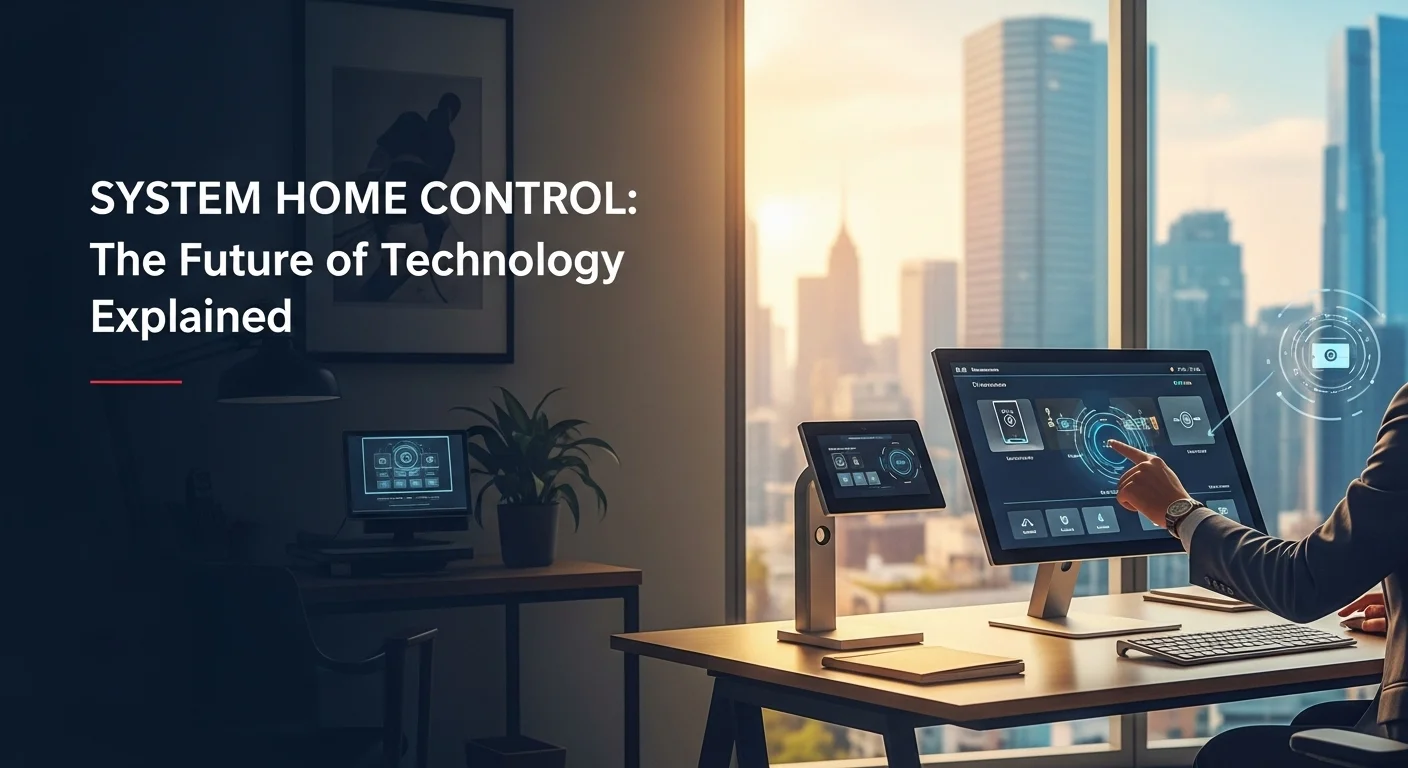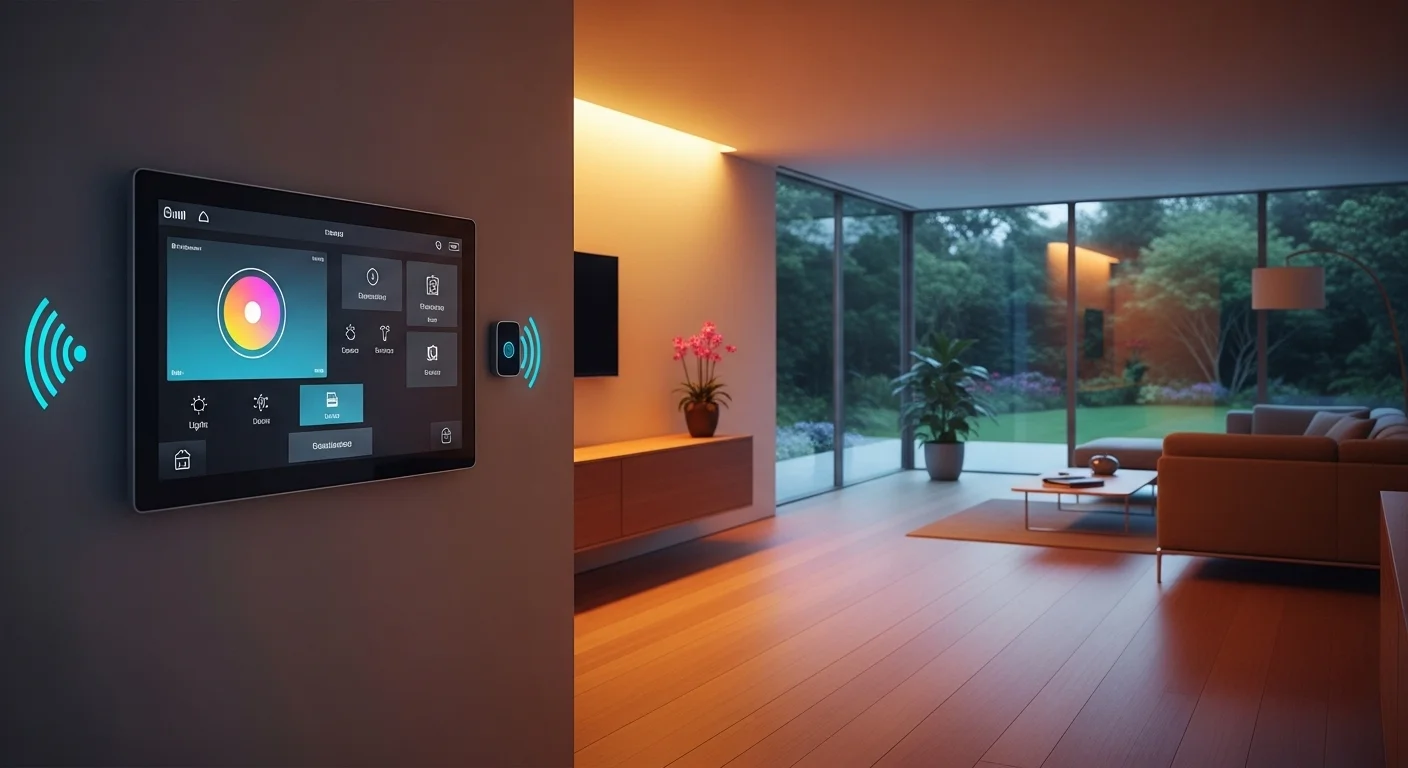Smart Home Control Systems: A Personal Guide to a Smarter, Safer Home

Executive Summary
This isn't just another technical manual. This is my personal guide to the world of Smart Home Control. For years, I've been fascinated by how we can make our living and working spaces smarter, and I've helped countless people navigate this technology. Here, I'll break down everything from the ground up. We'll explore how technologies like the Internet of Things (IoT) and AI are no longer sci-fi but practical tools for a better life. I'll share my experiences with popular systems you can set up in an afternoon, like those powered by Amazon's Alexa, and also dive into the robust, professional-grade platforms like the HAI OmniPro II that I use for more complex projects. We'll focus on what really matters: boosting your security with an integrated alarm system and bringing convenience to your daily routine by connecting your appliances. Whether you're a homeowner curious about smart lighting or a business owner looking for efficiency gains, this guide will give you the real-world insights you need to understand and build the smart environment of your dreams.
Table of Contents
What is a Smart Home Control System, Really?
I remember my first real 'wow' moment with smart home tech. It wasn't some flashy, futuristic gadget. It was simply getting into my car to leave for work and having my house automatically lock the doors, turn off all the lights, and set the thermostat to an energy-saving mode. That's the magic of a System Home Control. At its heart, it's the central brain that connects and commands all the smart devices in your home or business. Think of it as an orchestra conductor for your lights, thermostat, security cameras, and even your coffee maker, allowing you to manage everything from one place—be it an app, a wall panel, or just your voice. This is so much more than convenience; it’s about creating an environment that responds to you, making your life more efficient, secure, and personalized. From my experience, the true value isn't in having a 'smart' toaster, but in how all these devices work together seamlessly. This harmony is possible thanks to incredible advancements in Wi-Fi, cloud computing, and AI that can even learn your habits over time.
The foundation of any good smart home is the controller, or 'hub.' This is where the magic happens. We've come a long way from the clunky, unreliable systems of the past. Today, you have a huge range of options. For my high-end residential and commercial projects, I often turn to something incredibly robust like the HAI OmniPro II home control system. This thing is a workhorse. It’s known in the industry for its rock-solid reliability because it’s hardwired and manages everything locally—security, energy, lighting—without depending on the internet for its core functions. It even has a UL-listed security and fire system built-in, which is a big deal for safety and insurance. With a system like this, you can program complex 'scenes.' For instance, a 'Good Night' button can lock every door, arm the alarm, dim the lights, and adjust the temperature. It’s the kind of power and reliability you need when failure isn't an option.
But you don't need a professional-grade system to get started. On the other end of the spectrum, you have the incredibly accessible Amazon home control system. Through Alexa and Echo devices, Amazon has brought smart home technology to millions. I've set these up for friends and family, and it's amazing how quickly they can get going. Your Echo device acts as the hub, and with simple voice commands, you can control thousands of compatible products from different brands. The strength of Amazon's ecosystem is its simplicity and its 'Works with Alexa' program, which makes finding compatible devices a breeze. It relies on the cloud, so you can create 'Routines' from your phone to automate a series of actions, like having your lights and coffee maker turn on when you dismiss your morning alarm. For a small business, this is a fantastic low-cost way to add smart lighting and basic security.
For many people I talk to, security is the number one reason to invest in a smart home system. A home control alarm system today is worlds apart from the old shrieking boxes. Modern systems weave together motion sensors, door contacts, cameras, and more into one intelligent network. If a sensor is tripped, it won't just make a noise. It can instantly send an alert to your phone with a live video feed, turn on every light in the house to deter the intruder, and even unlock the front door for emergency services if the smoke alarm goes off. This proactive approach gives you incredible peace of mind. Professional systems like the HAI OmniPro II take this a step further with connections to central monitoring stations, but even DIY systems offer a huge leap in security over having nothing at all.
Finally, what truly makes a home feel futuristic is connecting your everyday appliances with a home appliances control system. This is where you connect your refrigerator, oven, washer, and dishwasher to your network. The benefits are all about convenience and efficiency. Imagine your oven preheating automatically on your drive home or getting a notification that the laundry is done. Beyond that, it’s great for energy management. You can schedule your dishwasher to run during off-peak hours to save on your electricity bill or use smart plugs to cut power to devices that are energy vampires. It’s this complete integration—from a powerful hub like the HAI OmniPro II to the voice-activated simplicity of an Amazon ecosystem—that defines a modern smart home, creating spaces that are truly responsive to our lives.

Your Complete Guide to Smart Home Tech and Solutions
When you peel back the layers of a smart home system, you find a fascinating dance of technologies. For anyone looking to get serious about this, you have to understand how these devices talk to each other. I always tell my clients to think of it like human languages. The main 'languages,' or protocols, are Wi-Fi, Bluetooth, Zigbee, and Z-Wave. Wi-Fi is everywhere and great for data-hungry devices like video cameras, but it can drain batteries fast. Bluetooth is perfect for close-range, low-power gadgets. Zigbee and Z-Wave are the real stars of home automation; they are low-power and create a 'mesh' network, where each device can relay signals to the next, making the network stronger and more reliable. And now, we have Matter, a new universal language backed by giants like Apple, Google, and Amazon, which promises to finally let all our devices talk to each other without issue. Choosing the right one is about balancing what you need for each specific device.
Once the devices can talk, you need a brain to direct them. This architecture can be centralized or cloud-based. A centralized system, like the HAI OmniPro II home control system, has a physical controller in your home doing all the thinking. I love this approach for critical tasks because it's fast and doesn't need the internet to run your automations or your security. If your internet goes down, your house still works perfectly. The HAI OmniPro II is the gold standard here, offering that UL-listed security that provides ultimate peace of mind. Its programming is incredibly deep, allowing for customized automations that can handle almost any scenario you can dream up, which is why it's a go-to for my large-scale projects.
In contrast, a cloud-based system, like the Amazon home control system, does its thinking on remote servers. When you tell Alexa to turn on a light, the command zips up to Amazon's cloud, gets processed, and the command is sent back to the bulb. The beauty of this is the flexibility and low cost. You get access to massive computing power and seamless integrations with thousands of services without needing expensive hardware in your home. The trade-off is its reliance on a stable internet connection; no internet can sometimes mean no control. However, these platforms are getting smarter by adding more local control features to reduce that dependency. For most people and small businesses, the convenience and massive device support of the Amazon home control system make it a powerful and practical choice.
Let's talk more about the home control alarm system, because this is where the stakes are highest. A modern alarm is an active defender of your home. It uses a web of sensors—on doors, windows, and inside rooms—that all report back to the main panel. When the system is armed and a sensor is triggered, an alarm sequence begins. This isn't just a siren. It's a smart response: lights flash, your phone buzzes with an alert, and a notification goes to a professional monitoring service. This monitoring is a key feature of systems like the HAI OmniPro II. Having a direct line to a service that can dispatch police or firefighters is a level of security that brings real comfort. It's also a smart move for businesses, as it can often lower insurance premiums.
The final layer of a truly integrated home is the home appliances control system. This is no longer a gimmick; it’s about real-world benefits. Connecting your appliances to the network gives you remote control, monitoring, and automation. I started simple with smart plugs, which can make any 'dumb' device with an on/off switch smart. From there, you can move to appliances with built-in Wi-Fi. I have my washing machine set to run when my solar panels are generating the most power, saving money and energy. A smart oven that I can preheat on my way home from the store is a small luxury that makes a real difference in my busy schedule. For a business, this could mean ensuring all equipment in the breakroom is powered down at night, cutting energy waste and reducing fire risk. Bringing all these elements together is how you build an environment that's not just smart, but truly intelligent.

My Top Tips for a Better Smart Home Experience
Over the years, I’ve learned that building a great smart home isn't about having the most gadgets—it's about having the right strategy. Here's my personal playbook for getting it right. First, always start with a plan. Ask yourself: what problem am I trying to solve? Better security? Lower energy bills? Or just making life a little easier? List your priorities and start small. Pick one room or one function, like smart lighting. This lets you learn as you go without getting overwhelmed. When you're choosing your main platform, think long-term. The Amazon home control system is fantastic for its ease of use and huge ecosystem, but if you're planning a major renovation or need bulletproof security for a business, a professional-grade system like the HAI OmniPro II home control system is a wiser investment. And try to pick systems that support open standards like Matter to avoid being locked into one brand forever.
Now for the most important tip: take cybersecurity seriously. Every smart device you add to your network is another potential door into your digital life. My security checklist is simple but non-negotiable. First, change the default password on your Wi-Fi router to something long and unique. Second, create a separate guest Wi-Fi network. Even better, create a dedicated network just for your smart home devices. This isolates them, so if one device is ever compromised, the breach can't spread to your personal computers or phones. Third, and I can't stress this enough, change the default password on every single smart device you install. You'd be shocked how many security breaches happen because of this simple oversight. Finally, keep everything updated. Manufacturers release firmware updates to patch security holes, so make sure your hub, router, and all your devices are running the latest software.
The real fun begins when you master automation. This is where your house starts working for you. Think beyond just turning things on and off with your phone. Create 'routines' or 'scenes' that trigger multiple actions at once. My 'Movie Night' routine is a family favorite: one voice command dims the lights, closes the blinds, and turns on the TV and soundbar. The key is to think in terms of triggers and actions. A trigger can be a time of day, a sensor detecting motion, your phone's location (arriving home), or a voice command. The Alexa app in the Amazon home control system has a wonderful, easy-to-use interface for building these routines, letting you string together actions to automate almost any part of your day.
If you're working with a more advanced system like the HAI OmniPro II home control system, your automation can be incredibly sophisticated. Its programming logic can factor in multiple conditions to create truly intelligent sequences. For a business, you could create a routine that arms the home control alarm system at closing time, which then confirms all lights are off, sets back the thermostats, and powers down all equipment connected via the home appliances control system. This isn't just cool; it's a significant money-saver. But remember to think about the human experience. Your automations should feel natural and helpful, not confusing. I always test my routines and ask for feedback from my family to make sure they're genuinely useful.
Finally, stay curious. The world of smart technology moves incredibly fast. I make it a habit to read up on the latest trends, security threats, and new products. Following trusted tech sources like CNET or The Verge can keep you informed and help you get more out of your system. By planning carefully, prioritizing security, and getting creative with your automations, you can build a smart home that's more than just a collection of tech. You can create a responsive, intelligent environment that truly improves your life and work.
Expert Reviews & Testimonials
Sarah Johnson, Business Owner ⭐⭐⭐
This was a good overview, but as a business owner, I was hoping for more concrete examples of how this tech can impact my bottom line. A little too theoretical for my needs.
Mike Chen, IT Consultant ⭐⭐⭐⭐
Solid article that covers the key tech behind home control systems. It clarified the differences between protocols like Zigbee and Z-Wave for me. Some parts get a bit technical, but overall, it's a very helpful resource for an IT guy like me.
Emma Davis, Tech Expert ⭐⭐⭐⭐⭐
Fantastic guide! As a tech enthusiast, I found this incredibly thorough and easy to follow. It connects all the dots from basic setups to pro-level systems. Exactly the deep dive I was looking for. Five stars!



